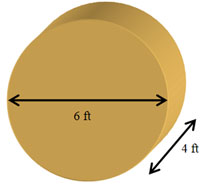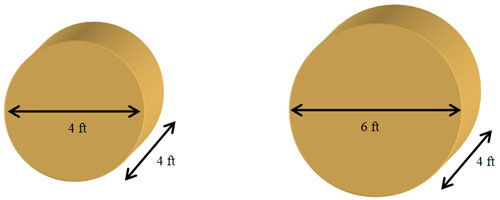V = πr2h
V ≈ (3.14)(32)(4) or about 113 ft3


In this section, you will be comparing volumes of similar and non-similar cylinders.
If you know anybody who owns a horse, they could use the information you are about to see! A round bale of hay is in the shape of a cylinder with a diameter of 6 feet and a height of 4 feet.
About how many cubic feet of hay does this bale contain? Remember, the formula for the volume of a cylinder is V = πr2h, find the radius first!
If the dimensions of the bale of hay were cut in half, what would be the new volume of the bale of hay?
When the dimensions of the bale of hay were cut in half, what was the change in volume of hay?

In reality, round bales of hay are almost always 4 feet in height. However, the diameter of the bale often varies. Find the volumes of the two bales of hay shown below.


The diameter (and radius) is larger in the second bale by a factor of 1.5, but the heights of the bales are the same. It appears as if only one dimension (diameter or radius) is changing. However, in the volume formula, the radius is squared so it counts as a factor in the formula twice. What is the change in volume?